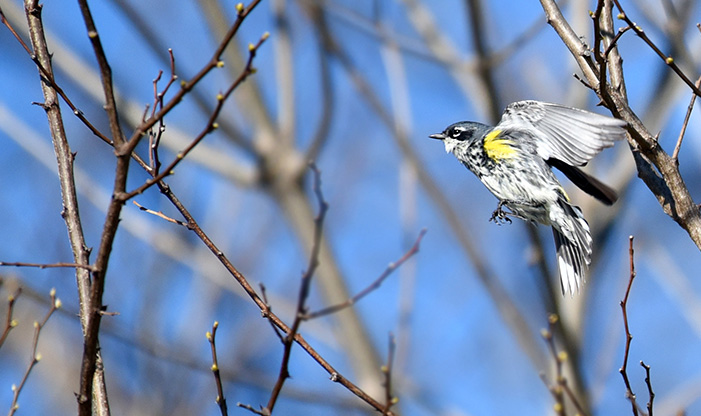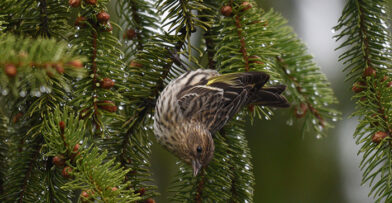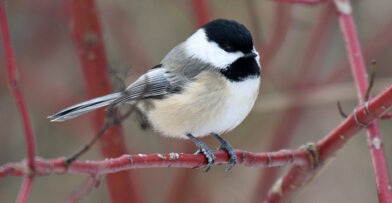Birders are excitedly donning their binoculars to take in the spectacular views. It’s time for spring bird migration, and avian aficionados have been anticipating this event all year! Many birds stop in Wisconsin to nest or on their way further northward, with male birds distinguished by their bold coloration designed to attract females.
Of the world’s total species of birds, 40 percent, or 4,000 species, are migrants. In North America, which has more than 650 species of breeding birds, more than half are migratory. The species visiting Wisconsin will pass through in a colorful wave that transfixes bird watchers. Between March and June, close to 300 species of birds stop within the state in a given year.
The male Red-winged Blackbird is a harbinger of the season. A dashing glossy black creature, it sports signature red epaulets bordered with patches of yellow on its wings, which they puff up when defending their territory. Listen for the male’s song “conk-la-ree!” And, while drinking in the sights and sounds of the beginning wave of bird visitors, take a moment to consider how intricate migration is.
The Great Yearly Flight North
The word migration means to pass periodically from one region or climate to another. Birds stop in Wisconsin every spring while flying northward to establish a nesting territory. It’s the continuation of a great yearly cycle for birds that winter in South America, Central America, the Caribbean, or the southern United States.
Food is ample in the warmer weather and nesting sites abound. Often, the first birds to make it to a nesting site will have the best chances of obtaining good territory, finding mates, and hatching healthy young able to survive the trip back south.
Flying long distances is difficult and filled with risks. Nevertheless, the trip is well worth it. Birds wouldn’t migrate if it wasn’t worth the energy expenditure and physical risk; the food that becomes available, as well as access to good breeding grounds, make the migratory trip worthwhile for their survival as a species.
Maps, Rest Stops, and Triptychs
Birds follow migration routes to get to their destinations. There are four migration routes in the US called flyways: the Pacific Flyway, Central Flyway, Mississippi Flyway, and Atlantic Flyway. Geological features determine flyways, and all of them have qualities that help birds navigate on their trips.
In general, birds visiting Wisconsin fly up the Mississippi Flyway. In North America, the route‘s western border roughly follows the Mississippi River, and is about as wide as four to five states eastward. Birds stop at various locations along the entire route where they rest and find food. They’re called stopover sites. Some sites are like gas stations, spots to stop for a quick refueling. Others are like bed and breakfasts, with quality food and amenities for staying from two days to a week. Many sites along the Mississippi Flyway are maintained well, so birds have a great location to rest, with access to food and shelter.
Locally, Schlitz Audubon is a great stopover site, where birds typically stay from two days to a week. We have concentrated green spaces, an abundance of food, and access to the Lake Michigan shoreline. There are four main habitats: woodland, prairie, wetland, and Lake Michigan.
Each habitat attracts different species. In the woodland habitat, look for woodpeckers and warblers. Prairies are a favorite for sparrows, American Woodcocks, Sandhill Cranes, Red-tailed Hawks, and Kestrels. The Sora, Green Heron, and American Bittern will visit wetland habitats. Lake Michigan will attract Solitary Sandpipers and Spotted Sandpipers, as well as gulls and terns.
Marvel at the Avian Arrivals
In March, look for the Wood Duck, a water bird that has complex, ornate patterns on its feathers touched with iridescent green. It’s one of the few species of ducks that perch on branches.
Another early migrant, the Killdeer sounds like its name. See the light brownish coloration with darker stripe around its neck as it darts emphatically to turn up prey insects. You’re likely to see the Golden-crowned Kinglet in March as well. It has a distinctive yellow crest on top of its head just above a big brownish-black eyebrow stripe. Likely, it will be high up in spruce or fir foliage.
A Torrent of Exotic Colors
One wondrous spectacle in April is the arrival of Sandhill Cranes, notable for their tall gray bodies and crimson caps. During spring migration, they often fill the sky by the thousands at locations like Horicon Marsh. Also in April, begin the foray into a world of exotic color with the Yellow-rumped Warbler. Streaky blue-gray and yellow, these warblers molt in spring and fall, displaying a yellow patch on their rump and head, with charcoal black and gray contrasted with bright white. The Savannah Sparrow is a slightly less dramatic white and contrasting brown, often with a telltale yellow eyebrow line. It is one of the most numerous songbirds in North America.
The Peak of Spring Migration
Birding season hits a crescendo in May when up to 30-plus species of the most vibrant migrants, the warblers, arrive in full force. The male Black-throated Green Warbler is a canopy dweller with a black throat and chest, a bright lemon cheek, and white-striped black wings.
Also, look for an amazingly bright, distinctive buttery yellow bird with chestnut streaks on its chest and belly, the male Yellow Warbler. The Wilson’s Warbler is a splash of sunlight, whose black cap and yellow plumage will be seen perching on low branches. Warblers are long-distance travelers, making the springtime journey from Central America and the tip of South America.
In vivid contrast to the bold yellow colors of warblers, the all-blue male Indigo Bunting is a bursting patch of deep-colored sky singing from the highest perch. Another radiant dash of color is the male Ruby-throated Hummingbird, a bright, tropical green and red-throated bird.
The wonders of illuminating color and delightful song are rolling through Wisconsin, where birders can take part in witnessing the spectacular migration journey in their neighborhoods and backyards. So get out your binoculars and enjoy the best of spring bird migration!
Written with contributions from: Marilyn Bontly, Zoe Finney, Don Quintenz, and Jean Strelka.


